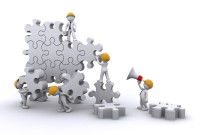- Home
- Business Processes
- Industry Knowledge
- Aerospace Industry
- Automotive Industry
- Banking Domain
- BFSI Industry
- Consumer/ FMCG Industry
- Chemicals Industry
- Engineering & Construction
- Energy Industry
- Education Domain
- Finance Domain
- Hospitality Domain
- Healthcare Industry
- Insurance Domain
- Retail Industry
- Travel and Tourism Domain
- Telecom Industry
- Leadership Skills
- eLearning
- Home
- Leadership Skills
- Leadership Theories
- Cognitive Resource Theory
Cognitive Resource Theory
The cognitive resource theory states the influence of the leader's resources on his or her reaction to stress. The cognitive resources of a leader are experience, intelligence, competence, and task-relevant knowledge. Stress is common in resource managing situations, and this cognitive theory emphasizes how intelligence and experience are each best under different stress situations. This theory is the reconceptualization of the Fiedler model.
In the early 1990s, the original model of Fiedler was re-conceptualized by Fiedler and his associate Joe Garcia, as Cognitive Resource Theory. In this model, the focus has been laid on the role of stress as a form of situational un-favorableness and how a leader’s intelligence and experience influence her/his reaction to stress.
What is meant by cognition?
Cognition is the mental action or process of acquiring knowledge and understanding through thought, experience, and the senses. Good examples of cognition are learning and our ability to reason through logic. Cognitive processes use existing knowledge and generate new knowledge. Cognitive processes are analyzed from different perspectives within different contexts like psychiatry, psychology, education, philosophy, and computer science.
Cognitive Resource Theory of Leadership
The Contingency Model developed by Fiedler was criticized for its lack of flexibility and also over the accuracy of the LPC scale. Fiedler then went on to develop the Cognitive Resource Theory (CRT) which takes into account the personality of the leader, degree of situational stress, and group-leader relations.
The assumption behind this theory is that stress impacts the ability to make decisions. It is the enemy of rationality and a leader cannot think in a logical and analytical manner if she/he is under a high level of stress. According to this proposition, the importance of a leader’s intelligence and experience to effectiveness differs under low and high-stress situations.
Fiedler and Gracia state that a leader’s intellectual ability correlates positively with performance under low stress but negatively under high stress. And conversely, a leader’s experience correlates negatively with performance under low stress but positively under high stress.
Thus, according to Fiedler and Gracia, the level of stress in a situation, determines whether an individual’s intelligence or experience will contribute to leadership performance.
Predictions of Cognitive Resource Theory
The Cognitive Resource theory predicts that the leader's abilities and intelligence can aid organizational success only when leaders adopt a directive leadership style, the situation is stress-free, the group members are supportive and the task requires high intellect. These attributes are discussed below:
1. Directive Approach
When a leader is better in cognitive abilities like intelligence, planning, and decision-making, he must follow a directive approach to improve the overall performance of the team. He needs to communicate to the group what to do, to ensure his plans and decisions are implemented, hence improving the overall performance of the group.
When the group and the people on the group are better than the leader in cognitive abilities, then the leader should choose a non-directive approach. He should seek ideas from the group and identify the best approach/idea and move ahead with the same.
A leader's cognitive ability contributes to the performance of the team only when the leader uses the directive leadership style.
2. Impact of Stress
Stress has a direct co-relation with intelligence and decision quality.
When there is a low stress, then intelligence is fully functional and makes an optimal contribution.
When there is high stress, natural intelligence does not make any difference, but may also have a negative effect.
3. Supportive Group Members
A leader's abilities will contribute to group performance only when group members are supportive of the leader and his goals. In such a situation leader's directions can be easily followed and implemented.
4. Cognitively Demanding Tasks
The intellectual abilities and intelligence of the leader can only be utilized efficiently in difficult, cognitively demanding tasks.
What are the practical applications of Cognitive Resource Theory?
The theory proposes the style of leadership required depending on three variables – the degree of stress, situational control, and task structure.
Leaders should be trained on stress management so that a leader's intellect can be most effectively utilized and also to train leaders to take a directive approach when their knowledge will benefit the group but a less directive approach when group member abilities will contribute to performance.
Based on this theory, for a given situation, depending on the level of the stress, leaders can decide on whether to rely on intelligence or on experience. For low-stress situations, one should rely on intelligence; however, for high-stress situations, one should rely on experience.
In high-stress situations, leaders who are more experienced will produce more quality results. In high-stress situations, rational solutions are generally not available and hence intelligence will not be able to support the decision-making process, whereas previous experience can allow the leader to react.
What are the cognitive resources of the self?
The cognitive resources of a leader refer to their experience, intelligence, competence, and task-relevant knowledge. A leader's knowledge can contribute to performance if it is efficiently communicated, hence requiring a directive leader and also a compliant group that is willing to undertake the commands of the leader.
Related Links
You May Also Like
-
The social identity theory of leadership views leadership as a group process. Social identity is a person's sense of who they are based on their group membership. Social identity theory sets agendas and goals generated by social categorization, defines who we are based on processes associated with social identity, and motivates to conduct ourselves based on what followers think of the leader.
-
Generating Ideas using Brainstorming
The brainstorming technique was developed by Alex F. Osborn in 1957 and brainstorming means where a team of members generates a large amount of alternative fruitful ideas on a specific problem without any criticism and then evaluates each idea in terms of their pros and cons. Brainstorming techniques fall into four broad categories: visioning, exploring, modifying, and experimenting.
-
McGregor's Theory X and Theory Y
McGregor created Theory X and Theory Y of human work motivation and explained two styles of management known as authoritarian (Theory X) and participative (Theory Y). Theory X management assumes most people will attempt to avoid work whereas Theory Y managers trust their people to take ownership of their work.
-
The great man theory of leadership is a 19th-century idea that states a person is either a natural-born leader or not. Some people are born with the necessary leadership attributes that help them create a great impact on society, politics, or the military. The theory focuses on identifying the innate qualities and characteristics possessed by great men.
-
Action Centered Leadership is a model developed by John Adair and focuses on the three responsibilities of a leader which are achieving the task, managing the team, and managing individuals. All these action elements are mutually dependent and important for any leader.
-
Management theories are the recommended management strategies that enable us to better understand and approach management. Many management frameworks and guidelines were developed during the last four decades.
-
Leadership has been defined in different ways by different sets of scholars. In very simple terms leadership can be defined as the skill of a person to influence an individual or a group for achievement of a goal in a given situation. One can use different dimensions and perspectives to define leadership. Through the evolution of leadership thought, leadership has been defined in various ways discussed here.
-
Investment Theory of Creativity
Sternberg in the year 2006, proposed the investment and confluence theory focused on understanding creativity. According to the investment theory, creativity requires a confluence of six distinct but interrelated resources known as intellectual abilities, knowledge, styles of thinking, personality, motivation, and environment. It emphasizes that creativity is not about one thing, but about a system of things.
-
The Fiedler Model of leadership is a contingency theory and states that a leader's effectiveness is based on the situation. There is no one best style of leadership and the effectiveness of a leader in an organization depends on matching the leader to the situation. Leaders should determine the natural leadership style and assess the situation to flex the style.
-
Humanistic theories of Leadership
Humanistic leadership is an ethical philosophic approach that recognizes the dignity and worth of each and every group or team member. This approach is based on building a leadership culture of trust, ethics, and empathy. Humanistic leadership is a set of principles founded on humanism with vision, mission, values, and expected behaviors. It is value-driven leadership based on principles such as humility, accountability, positivity, and love.
Explore Our Free Training Articles or
Sign Up to Start With Our eLearning Courses

About Us
Learning
© 2023 TechnoFunc, All Rights Reserved










